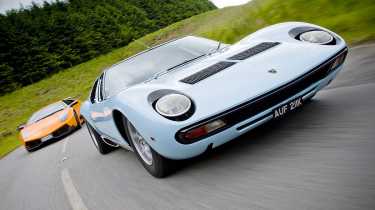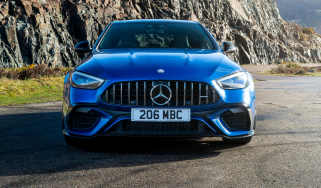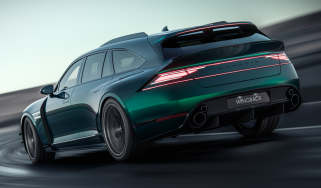Think back to the first time you saw a supercar. You probably had the same sense of excitement, awe and wonder that I felt when the wide low orange wedge was being backed off the transporter first thing this morning. Clearly I’ve been jammy enough to drive quite a few supercars, but the excitement is still always tempered by a slightly uncomfortable sense that you are about to get into an unwieldy, perhaps uncontrollable machine. A supercar is monstrous yet precious and will make you nervous just thinking about driving it. And if you are one of those rare people who have supreme confidence and don’t know what I’m talking about, then try driving a Lambo between two rows of parked cars in a cramped town centre, with no rear vision but a good grasp of the fact that the entire population is standing or leaning out of windows to see if you’ll make it through without a scratch… Once we emerge from Llareggub (thankfully with all layers of paint intact) we head towards the wider roads of the Beacons. Wider but not smoother, and they reveal a depth to the LP670 that I hadn’t expected. Despite the much firmer control of the SV’s suspension compared with the standard car, the horribly churned tarmac is simply soaked up. Relatively dinky 18in rims probably help, but it still seems spooky the way this hardcore car is gliding across the troubled asphalt. The SV is demonstrably, demonically different to the standard car in other ways too, the steering heavier and meatier, the grip more insistent but edgier and the engine so nuts that as John Barker says, ‘beyond 6000rpm it seems to have broken free of its shackles and about to rev itself to oblivion’. After a while we stop so that Matt Howell can get a few photos onto his memory cards. Then half an hour later he signals that it’s time to roll out again and Ian Tandy, the owner of the Miura, asks if I’d like to drive his car. Gulp. After a restoration that redefines the word meticulous, his car actually looks like it rolled out of the Sant’Agata gates more recently than the Murciélago. In fact this SV (one of only 150 in total and fewer than ten right-hand drive) was originally owned by Tony Iommi, bassist in Black Sabbath. Mr Iommi ordered chassis number 4814 in 1971 in the most desirable spec available, with air conditioning and a split sump. Since then it’s belonged to, amongst others, a Scottish potato farmer (records are unclear as to whether he thought he was buying a tractor) and collectors Sir Anthony Bamford and Simon Draper. It even appeared back in issue 50 of evo as the world’s sexiest car. The driving position is a sort of one-size-fits-all, with the emphasis on the driver instead of the car making the adjustments. Fixed seat, fixed steering column, fixed pedal box. My arms seem to be stretched out, while my legs are bunched up and splayed akimbo round the wheel, with my knees definitely nearer my ears than is natural. It’s not unlike the position you’d adopt if, after one too many sherbets, you thought it would be fun to try to get into and then operate a child’s pedal car. The simple key is down on the transmission tunnel and the switches for various illuminations, fans and heaters are up in the roof near the rear view mirror, so starting the Miura feels a bit like running through pre-flight checks. The fact that the throttle (which I’ll come back to in a second) needs pumping vigorously while you turn the key and wait and wait for the engine to catch only adds to the similarities with getting a light aircraft going. The handbrake is iffy, the gearbox won’t go into first and we’re on an upslope, but with my heart ticking over considerably faster than the engine we miraculously get away first time. There is no rushing the gearbox and it needs a calm but firm hand, feeling delicate because of the wand-like gearstick but chunky because of the mechanicals below. You slide it out of one heavy, oiled cog, sense the lightness through neutral and then push with smooth pressure to slot into the next gear. The accelerator pedal is beyond sticky. As John says, ‘opening 12 throttle butterflies with a cable that loops and twists from the throttle pedal to somewhere over your shoulder isn’t going to give precision control’, but even so it’s hard to recalibrate a mind used to featherlight electronic or even recent cable-operated throttle pedals. If you stomped on the Murciélago’s accelerator with the force that is required in the Miura then you would probably snap your own neck. John’s up ahead in the Murci and indicating right. Bit of traffic coming so he rolls to a halt. Brake. Oh dear Lord where’s the brake pedal? I mean literally where is it? My contorted foot has hit fresh air where it anticipated a middle pedal and now my generous braking distance is shrinking as quickly as my panic is rising. Come on, come on. Don’t miscue and go back to throttle. Where is it? There it is! And the brakes are actually alright too, thank God. Unthinkable million pound disaster averted, we wind our way out across more open countryside and gradually I start to relax again. Third and fourth are all you need out here and there’s plenty of torque. The ride gives you confidence, the Miura feeling settled over the bumps and cambers, the 275/55 R15 Avons (they don’t make the original Pirelli Cinturatos any more) tracking smoothly underneath you. Although there’s nothing really over the front end, it’s still a surprise that the steering is relatively light given the relative weight of the other controls. It’s communicative too, the unasssisted rim weighting and unweighting in your hands as you guide the nose accurately into a corner before metering out the throttle travel in jerky chunks as you use the power to drive through and down the next straight. A firework of small explosions crackles from the exhaust as I back off to give a wandering sheep a wide berth. A glance in the rear-view mirror (no wing mirrors) is like looking at the Welsh landscape through a Venetian blind. Sheep have become zebras. A couple more miles. We pull over and I start breathing again (whilst blipping the throttle to keep the engine going). It is an absolute privilege and a thrill to be allowed to drive a Miura SV, particularly one as immaculate as this. But it is also a huge responsibility, and in the same way that you want to meet your heroes long enough to say ‘hello’, you don’t want to go much further for fear that one of you will say something so disappointing or embarrassing that it spoils the moment forever. In all honesty the Miura has more in common with a car built 40 years before it than it does with a car built 40 years later, so I’d rather just look at it for the rest of the day. I know I won’t be disappointed doing that. Look at the Miura and drive the LP670. In truth, although some might reminisce through rose-tinted glasses and claim that cars were better when it was all purely mechanical, 21st century supercars are capable of delivering driving highs that the older generation simply can’t match. Many of the old generation of supercars claimed extraordinary numbers and may even potentially have had the performance to live up to their looks. But the chances of actually getting near the limits and the numbers that smacked your gob (and made you desire the car so much) were miniscule unless you had plums the size of cantaloupes and the skill of Ricardo Patrese. Now, thanks to tyre and suspension technology, aerodynamic modelling, carbonfibre and, probably most of all, the microprocessor (40 years ago just one megabyte cost approximately $1million; today it costs a fraction of a dollar) supercars are more exciting and driveable than ever. Would I want to drive an early Diablo up the side of this Welsh mountain? Yes. Of course I would. But would I, could I, hustle one relentlessly, corner after corner, pushing grip limits in the way that I’ve just done in the brilliant LP670? No. Don’t think that driving the Murciélago is as simple as driving a Mondeo because it’s not. You feel your concentration spike every time you drop down into the seat (which actually needs a bit more lateral support) and turn the key. The forces that it exerts on you under acceleration, or when you hit the huge carbon brakes (they still need more progression, but they’re much better than in the Gallardo) or when you lean on the Pirelli P Zero Corsas are massive and intimidating. To keep your foot pinned on a valley road, accelerating unremittingly as you flick each gear at the limiter and watch the strip of tarmac in the windscreen narrow relentlessly around the car as the speed builds, is to be immersed in an unforgettable supercar experience. But I like the fact that it still feels planted at 170mph, not flighty and lethal. It makes me want to go back to 170mph and experience it again, push further. And in the corners it is even more noticeable. On entry you can brake so late you’re weightless in the seat belt. Turn in and you can adjust the balance through the corner. Because it corners flatter and there’s more edge to the grip, the nose of the LP670 actually pushes more obviously than the LP640. As a result you need to play sensitively with the throttle and steering through a long corner, leaning into the invisible lateral G but feeling the fluctuations in load as you adjust your inputs. Bumps are soaked up and telegraphed by the SV’s suspension in a way you can compensate for. You don’t jump on the throttle early in the corner because the big rear tyres will push the nose wider still, so you wait until you’re past the apex, then you begin straightening the wheel and feeding in the power, using the traction of the rear-biased four-wheel drive to ride the furiously ignited torque. You can’t turn the ESP to Corsa mode and take ham-fisted liberties – there’s still a huge V12 slung behind you. But even on the road you can dig right into the Murci’s handling repertoire and enjoy it – not just nibble nervously at the edges. The Brecon Beacons echo to the sound of two V12s for the rest of the day. People stop and stare. Three men in a Transit held together with faith and copies of the Daily Star stop and chuckle that they wouldn’t get much in scrap for the Murciélago’s carbonfibre. Eventually we drag Matt Howell away from the Miura and, as darkness falls, we bid farewell to Ian Tandy, taking one last long look at the powder blue shape slinking away before heading East and home, stopping only to fuel up the LP670-4 ready for its big day tomorrow. Millbrook’s mile straight is slightly damp when we arrive and, although dry patches emerge, the conditions are far from ideal. And yet the SV is stunning. It is one of the most fun cars I’ve ever figured, partly because it feels mechanically happy repeating full-bore standing starts time after time and partly because of the dramatic way it gets off the line. To launch it you need to have Corsa mode engaged and TCS (Traction Control System) turned completely off. Then you simply engage first gear and stamp on the throttle. At this point the car twigs what’s going on, selects appropriate revs and dumps the clutch. All four wheels spin up, the car snaps sideways off the line, you apply half a turn of lock, ease the revs whilst keeping the wheels spinning all the way through first gear then time the flick of the right-hand paddle just before snagging the limiter at 8000rpm (no automatic upchange) and from then on it’s easy, just watch the rev- counter, keep changing up and bingo you’ve got your figures! The Miura recorded 6.0sec to 60mph in the early 1970s. After a couple of runs at 3.4sec in the Murciélago, we nail a couple more at 3.2sec. That, as I’m sure I don’t need to tell you, is McLaren F1 fast. Indeed the Lambo’s only a second behind the Macca at 100mph, yet it’s carrying 500kg more. Phenomenal. (Alright, so the big VW was even more phenomenal six days later, see page 91, but it didn’t oversteer on the way there, or sound like an ’80s F1 car). Round the lap the SV was like the standard Murciélago, only more. There was understeer, particularly through the Palmer Curves, which needed quelling with a little lift on turn-in, but the rear was absolutely hooked up except out of Bank. The man with the fastest name ever, Max Venturi (Lambo’s test driver) wasn’t surprised that the SV was almost 4sec quicker than the standard car but the 1.21.3 lap is even more impressive when you consider the only cars ahead of it are the Gumpert Apollo (effectively a race car) and the super-lightweights. John Barker and I agree that the standard Murci is enough really (and actually looks better), but also that that’s not really the point. Thoughts of sufficiency aren’t really applicable to a supercar and the LP670-4 takes everything gloriously to extremes. It also marks the Bizzarrini engine’s swansong and you have to wonder how many manufacturers will be willing or able to make such a gloriously politically incorrect engine in the future. Ferrari claims to be going lightweight, and Lamborghini is talking about green issues (and not lime green issues either). Which only makes the latest SV even more special. As John says, ‘it’s the fastest, hardest, maddest, baddest Murciélago, a car that deserves the SV badge as much as any car that has gone before’. And when the back catalogue of initialled cars includes a car as iconic as the Miura, that’s some accolade.
Lap Times
| Performance | LP 670-4 |
| 0-30 | 1.6 |
| 0-40 | 2.2 |
| 0-50 | 2.6 |
| 0-60 | 3.2 |
| 0-70 | 4.2 |
| 0-80 | 5 |
| 0-90 | 5.8 |
| 0-100 | 7.3 |
| 0-110 | 8.4 |
| 0-120 | 9.6 |
| 0-130 | 11.5 |
| 0-140 | 13.2 |
| 0-150 | 15.4 |
| 0-160 | 18.2 |
| 0-170 | 21.2 |
| 1/4 mile secs | 11.4 |
| 1/4 mile mph | 129 |
| In-gear times (2nd) |
| 20-40 | 2.3 |
| 30-50 | 2.1 |
| 40-60 | 1.9 |
| 50-70 | 1.8 |
| 60-80 | 1.7 |
| 70-90 | 1.6 |
| In-gear times (3rd) |
| 30-50 | 2.9 |
| 40-60 | 2.8 |
| 50-70 | 2.8 |
| 60-80 | 2.7 |
| 70-90 | 2.4 |
| 80-100 | 2.3 |
| 90-110 | 2.3 |
| 100-120 | 2.5 |
| 70-90 | 3.8 |
| In-gear times (4th) |
| 80-100 | 3.7 |
| 90-110 | 3.3 |
| 100-120 | 3.1 |
| 110-130 | 3.2 |
| 120-140 | 3.4 |
| 130-150 | 3.8 |
| In-gear times (5th) |
| 70-90 | 4.6 |
| 80-100 | 4.7 |
| 90-110 | 4.9 |
| 100-120 | 4.6 |
| 110-130 | 4.2 |
| 120-140 | 4.3 |
| Braking |
| 100-0 | 4.2 |
| dist. ft | 286.9 |
| 0-100-0 | 12 |
| Conditions: | slightly damp |
Comparison
| | Miura SV | LP670-4 SV |
| Engine | 60deg V12 | 60deg V12 |
| Location | Mid, transverse | Mid, longitudinal |
| Displacement | 3929cc | 6496cc |
| Bore x stroke | 82 x 62mm | 88 x 89mm |
| Cylinder block | Aluminium alloy | Aluminium alloy |
| Cylinder head | Aluminium alloy, dohc per bank, two valves per cylinder | Aluminium alloy, dohc per bank, four valves per cylinder |
| Fuelling | Four Weber carburettors | Multipoint fuel injection |
| Max power | 380bhp @ 7700rpm | 661bhp @ 8000rpm |
| Max torque | 286lb ft @ 5500rpm | 487lb ft @ 6500rpm |
| Transmission | Five-speed manual, rear-wheel drive, limited-slip differential Double wishbones, coil springs, anti-roll bars front and rear | Six-speed e-gear paddle-shift, four-wheel drive, front and rear limited slip differentials |
| Suspension | Double wishbones, coil springs, anti-roll bars front and rear | Double wishbones, coil springs, anti-roll bars front and rear |
| Brakes | Steel discs front and rear | Vented carbon-ceramic discs front and rear, ABS, EBD, TC |
| Wheels | 7 x 15in front, 9 x 15in rear, cast magnesium | 8.5 x 18in front, 13 x 18in rear aluminium alloy |
| Tyres | 215/70 R15 front, 275/55 R15 rear, Avon radial | 245/35 ZR18 front, 335/30 ZR18 rear, Pirelli P Zero Corsa |
| Weight | 1306kg | 1565kg |
| Power-to-weight | 295bhp/ton | 429bhp/ton |
| 0-60mph | 6.0sec | 3.2sec |
| 0-100mph | 13.4sec | 7.3sec |
| Top speed | 168mph | 212mph (claimed) |
| Basic price | c£11,000 (1972) | £221,335" |




